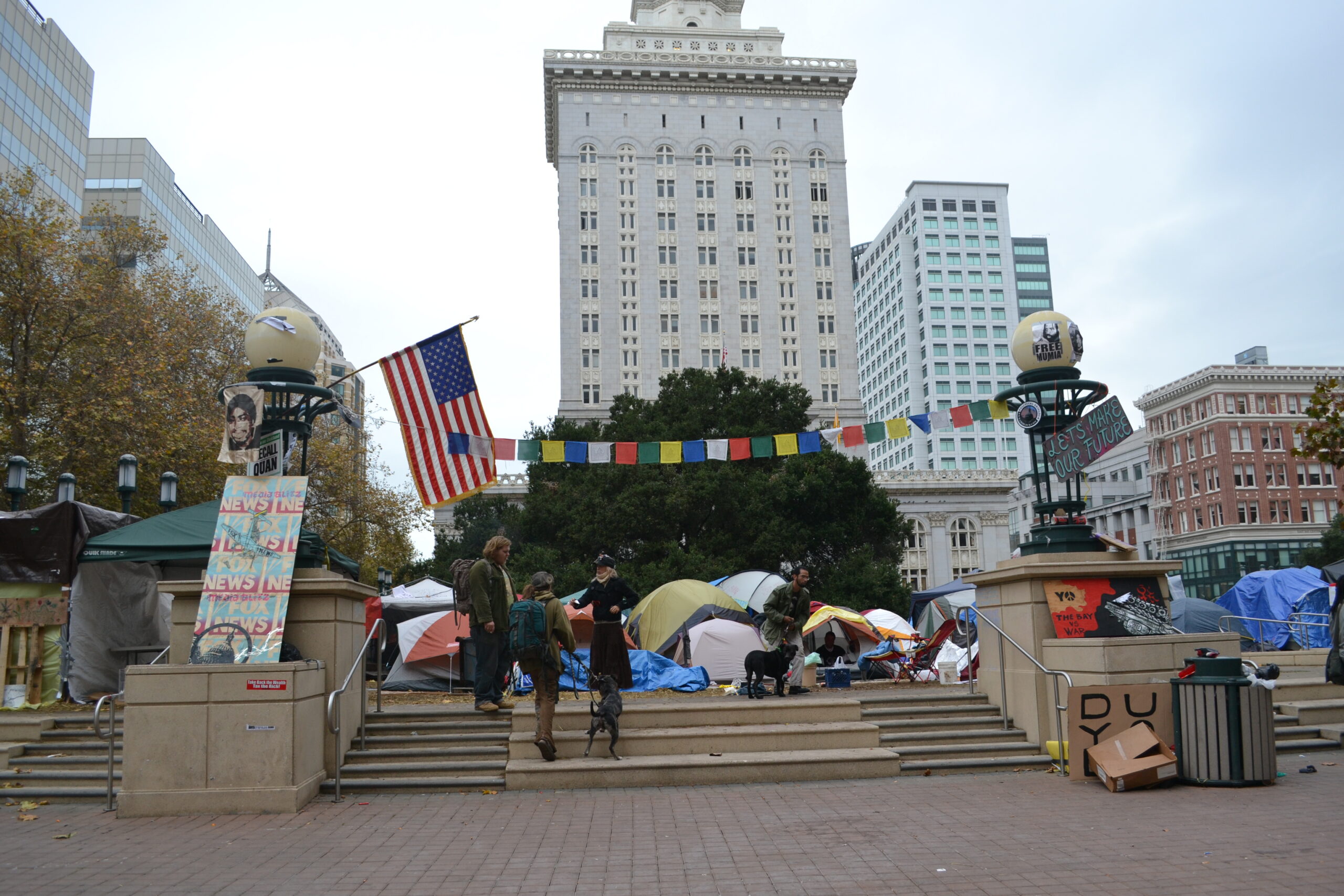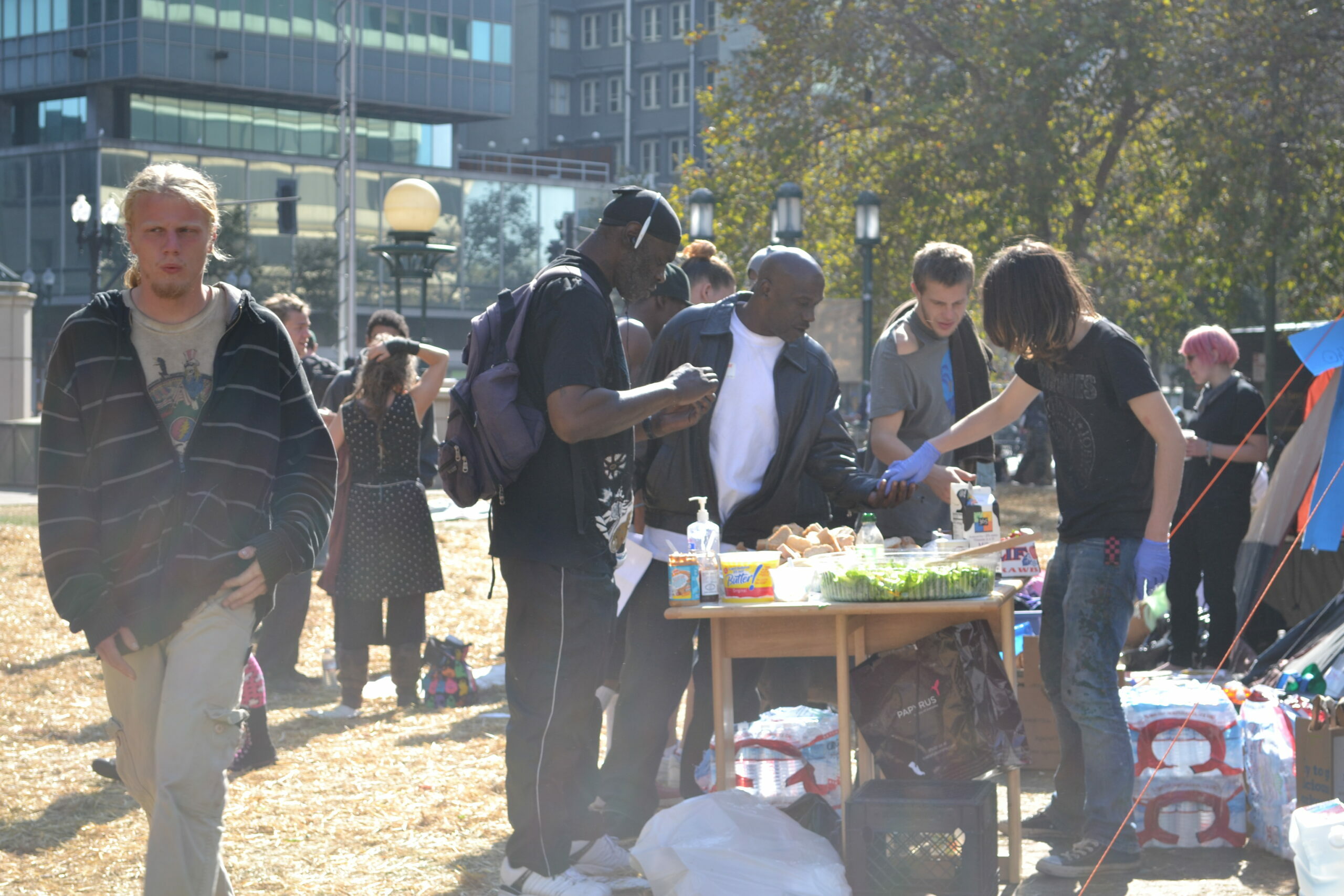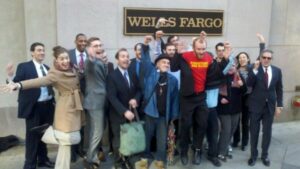
The messages we take from the stories of homeless people, veterans, women, indigenous peoples and volunteers involved with Occupy Wall Street demonstrate keen effectiveness and high spiritual status of the international movement. These points of hope are proof of the positive impact the Occupy movement is having.
Homeless Occupants

Oakland Mayor Jean Quan estimated November 10 that over half of the Oscar Grant Plaza campers were homeless, and she even handed out passes to safe houses in an effort to clear the park. If it’s true that so many occupations are central areas where homeless people are coming together, they deserve our support.
If one message we can take away is that safe houses aren’t safe or working, and if homeless people gain strength through being in community, then we should support them. If social problems are following homeless people into the central squares of our localities, and we don’t like to see it, then we need to address those problems instead shun them away back into the darkness.
More than 1.6 million children, or one in 45, are homeless annually in America, according to The National Center on Family Homelessness.
The tent camp at Oscar Grant Plaza brought together not only homeless people and political activists, but plenty of donations and professional volunteers providing basic services. Social workers, mediators, chefs, medics, children and all kinds of impoverished and well-off people coexist at the camp in a brand new pop-up organic community. All these people dance together at dance parties and stand up to police together at protests as they defend their right to this life together.
In a few months they have met and become a family, as they continue to do. Everyone offers what they have to contribute, in their most natural way. A general tone of acceptance rests at the camp. Personal expression and creativity are encouraged. An occupied public place is transformed into sacred space.
Members hold a 24-hour vigil to defend and sustain this new gem. Occupants are diverse in experience, tactics, ethnicity, and every possible way. Occupy Oakland is total coexistence in hope, joy, and service to humanity.
Two of the things all these people have in mind are the foreclosure epidemic and homelessness. More than 1.6 million children or one in 45 are homeless annually in America – according to a report by The National Center on Family Homelessness.
Veteran Occupants
Boston Police beat veterans on October 11 during an Occupy Boston tent camp raid. Sergeant Shamar Thomas on October 16 railed on New York Police, “There is no honor in this… to hurt unarmed civilians.”
Oakland Police severely injured Veteran Scott Olsen with projectiles while he was participating in a peaceful protest October 25, and he has continued to stand up for his country by joining Occupy Oakland since then. Veteran and local business owner Kayvan Sabehgi was beaten by police when walking down the street November 2 after the Oakland General Strike and underwent surgery for a wounded spleen. Marine Sean Palmer at Occupy Oakland supported the tree-sit at Oscar Grant Plaza in November.
In this country, 18 veterans commit suicide a day, according to numbers provided by the Department of Veteran Affairs.
The day before Veteran’s Day, news broke that a veteran committed suicide at Occupy Vermont. In this country, 18 veterans commit suicide a day, according to numbers provided by the Department of Veterans Affairs. The very people who give their lives for this country are being neglected at best.
The Occupations have their priorities straight. They are actively supporting veterans. Occupy Atlanta saved a veteran from losing her home to foreclosure in Georgia. According to Truthout, in California “Occupy Riverside activists helped an ex-Marine reoccupy the home that he and his family were evicted from as a result of foreclosure.” The Occupy Oakland Media site announced a Wells Fargo protest December 4 in support of 63 year old combat-injured Vietnam veteran Jerome Loston and his wife Linda who are facing foreclosure January 9.
Women Occupants
Friday, December 30, Occupy Oakland held a rally in solidarity with the women of Egypt. Speakers’ topics addressed issues of violence against women in its global context, referring to social problems abroad and at home. Several addressed the horrible impacts of war on women.
One in four teens in this country reports some form of teen dating violence every year – physical, verbal, emotional or sexual abuse.
One in four teens in this country reports some form of teen dating violence every year – physical, verbal, emotional or sexual abuse. Alameda County leads the nation in sexual exploitation of minors, classified as human trafficking. A new California law forces businesses to account for how they guard against slavery and human trafficking throughout their supply chains, while awareness on local sex slavery is rising.
The “Occupy (Decolonize) Pregnancy and Birth Caucus” of Occupy Oakland held a “Nurse In to Protest the Over Watering of Our Beloved Oak Tree” at Oscar Grant Plaza on December 17, and participated in a national nurse-in at Target Stores December 28 in Emeryville. There are many directions an Occupy-led focus on women may take as it matures.
Indigenous Occupants
At Occupy sites around the country, Native American communities have requested that the name “Occupy” be changed to “Decolonize.” The United States has been occupying indigenous lands since its birth, and the word “occupy” has an aggressive connotation especially from the indigenous standpoint.
Native American communities know well the struggles that poor people, veterans, and women face. They’ve also been dealing with exploitation, violence and militarism from the ruling class of the western hemisphere the longest. Native American community members have been coming out to show solidarity with Occupy Wall Street efforts, offered blessings to them, provided guiding wisdom to occupants, sat in trees and erected a teepee.
On Sunday December 4, the proposal at the Occupy Oakland General Assembly to change the name to “Decolonize Oakland” won 68% of the vote, but failed to pass as it required 90% approval. With or without the name change, occupies have become forums and stages for important voices to be heard, with indigenous peoples at the forefront.
Restoring justice in the United States begins with the indigenous, so having native voices up front is one organic process in the spiritual evolution that Occupy Wall Street has right.
Restoring justice in the United States begins with the indigenous, so having native voices up front is one organic process in the spiritual evolution that Occupy Wall Street has right. Being that all Americans benefit from being on these lands, to the detriment of its original inhabitants who to this day are experts at every social challenge the left knows, it is a responsibility of all justice seekers to honor indigenous peoples.
International Solidarity
Time Magazine reported about the October 28 rally in Cairo, Egypt’s Tahrir Square in solidarity with Occupy Oakland. Only a month later, a Time cover spread went viral, revealing that the December 5 magazine cover in Europe, Asia, and the South Pacific showed an Egypt protester wearing a gasmask, while the US edition of the same magazine had on its cover a cartoon about anxiety and health.
Weeks later in an act of poetic justice which could not redeem mainstream media from its corporate bias, the December 28 edition of Time named “The Protester” the person of the year, acknowledging “from the Arab Spring to Athens, from Occupy Wall Street to Moscow,” in the subtext.
Indeed, solidarity of the protests is real. On the national scale, Occupies support each other. Occupy Wall Street has provided significant funds to Occupy Oakland, for example. And the West Coast Ports Shutdown December 2 was continued into the following day, as Occupies had vouched that if there was any police brutality on that day, they would all extend their massive protests.
When Occupy Wall Street finally started, on the heels of the Israel tent camps, the London riots, and the Arab Spring, I tried to envision what it would look like if it continued on for months. I pictured everyday a fair, with nonprofit organizations tabling, exchanging information and people sharing ideas and getting educated – the left uniting. I have been beyond thrilled to find that the Occupy encampments and actions have gone far deeper than the silos and bureaucracies of nonprofit engagement and enthusiasm.

Instead of a showcasing and pleading for assistance, Occupy is live, it is authentic, it is living its vision for a new future. It is impacting public perceptions of these important issues with real information. Occupy is seeking systemic change, and their actions and priorities demonstrate the seriousness and effectiveness of its effort.
Bank transfers are great – anyone and everyone can relate to those. Millions of private individuals transferring their money out of corporate banks and in to local credit unions around Bank Transfer Day November 5 was an enormous social accomplishment. But let’s remember that the people at the tent camps and the 24-hour vigils are holding the physical spaces where many of these types of actions are organized and implemented.
If you’re from Oakland or another area, and you’ve had a NIMBY attitude about the occupations happening in your public neighborhood spaces, I can’t totally blame you. I hope once you understand the incredible changes being led by the movement that is based in those sacred spaces, that you will take a new approach. If you think the people out there need services, help get them those services. Speak at the GA. Join in the action.








